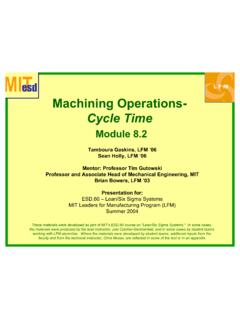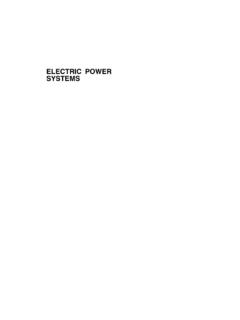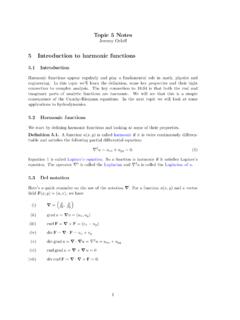Transcription of CHAPTER 8: MATRICES and DETERMINANTS - Math Notes …
1 (Section : MATRICES and DETERMINANTS ) CHAPTER 8: MATRICES and DETERMINANTS . The material in this CHAPTER will be covered in your Linear Algebra class (Math 254 at Mesa). SECTION : MATRICES and SYSTEMS OF EQUATIONS. PART A: MATRICES . A matrix is basically an organized box (or array ) of numbers (or other expressions). In this CHAPTER , we will typically assume that our MATRICES contain only numbers. Example Here is a matrix of size 2 3 ( 2 by 3 ), because it has 2 rows and 3 columns: 1 0 2 .. 0 1 5 . The matrix consists of 6 entries or elements. In general, an m n matrix has m rows and n columns and has mn entries. Example Here is a matrix of size 2 2 (an order 2 square matrix): 4 1 .. 3 2 . The boldfaced entries lie on the main diagonal of the matrix. (The other diagonal is the skew diagonal.). (Section : MATRICES and DETERMINANTS ) PART B: THE AUGMENTED MATRIX FOR A SYSTEM OF LINEAR EQUATIONS. Example 3x + 2 y + z = 0. Write the augmented matrix for the system.
2 2x z = 3. Solution Preliminaries: Make sure that the equations are in (what we refer to now as). standard form, meaning that . All of the variable terms are on the left side (with x, y, and z ordered alphabetically), and There is only one constant term, and it is on the right side. Line up like terms vertically. Here, we will rewrite the system as follows: 3x + 2 y + z = 0.. 2x z=3. (Optional) Insert 1 s and 0 s to clarify coefficients. 3x + 2 y + 1z = 0.. 2x + 0 y 1z = 3. Warning: Although this step is not necessary, people often mistake the coefficients on the z terms for 0 s. (Section : MATRICES and DETERMINANTS ) Write the augmented matrix: Coefficients of Right x y z sides 3 2 1 0 .. 2 0 1 3 . Coefficient matrix Right-hand side (RHS).. Augmented matrix We may refer to the first three columns as the x-column, the y-column, and the z-column of the coefficient matrix. Warning: If you do not insert 1 s and 0 s, you may want to read the equations and fill out the matrix row by row in order to minimize the chance of errors.
3 Otherwise, it may be faster to fill it out column by column. The augmented matrix is an efficient representation of a system of linear equations, although the names of the variables are hidden. (Section : MATRICES and DETERMINANTS ) PART C: ELEMENTARY ROW OPERATIONS (EROs). Recall from Algebra I that equivalent equations have the same solution set. Example Solve: 2x 1 = 5. 2x 1 = 5. 2x = 6. x = 3 Solution set is 3 .{}. To solve the first equation, we write a sequence of equivalent equations until we arrive at an equation whose solution set is obvious. The steps of adding 1 to both sides of the first equation and of dividing both sides of the second equation by 2 are like legal chess moves that allowed us to maintain equivalence ( , to preserve the solution set). Similarly, equivalent systems have the same solution set. Elementary Row Operations (EROs) represent the legal moves that allow us to write a sequence of row-equivalent MATRICES (corresponding to equivalent systems) until we obtain one whose corresponding solution set is easy to find.
4 There are three types of EROs: (Section : MATRICES and DETERMINANTS ) 1) Row Reordering Example 3x y = 1. Consider the system: . x+ y=4. If we switch ( , interchange) the two equations, then the solution set is not disturbed: x+ y=4.. 3x y = 1. This suggests that, when we solve a system using augmented MATRICES , . We can switch any two rows. Before: R1 3 1 1 .. R2 1 1 4 . Here, we switch rows R1 and R2 , which we denote by: R1 R2. After: new R1 1 1 4 .. new R2 3 1 1 . In general, we can reorder the rows of an augmented matrix in any order. Warning: Do not reorder columns; in the coefficient matrix, that will change the order of the corresponding variables. (Section : MATRICES and DETERMINANTS ) 2) Row Rescaling Example 1 1. x+ y=3. Consider the system: 2 2. y=4.. If we multiply through both sides of the first equation by 2, then we obtain an equivalent equation and, overall, an equivalent system: x + y = 6.. y=4. This suggests that, when we solve a system using augmented MATRICES .
5 We can multiply (or divide) through a row by any nonzero constant. Before: R1 1 / 2 1 / 2 3 .. R2 0 1 4 . Here, we multiply through R1 by 2, which we ( ) (. denote by: R1 2 R1 , or new R1 2 old R1 ). After: new R1 1 1 6 .. R2 0 1 4 . (Section : MATRICES and DETERMINANTS ) 3) Row Replacement (This is perhaps poorly named, since ERO types 1 and 2 may also be viewed as row replacements in a literal sense.). When we solve a system using augmented MATRICES , . We can add a multiple of one row to another row. technical Note: This combines ideas from the Row Rescaling ERO. and the Addition Method from CHAPTER 7. Example x + 3y = 3. Consider the system: . 2x + 5y = 16. Before: R1 1 3 3 .. R2 2 5 16 . Note: We will sometimes boldface items for purposes of clarity. It turns out that we want to add twice the first row to the second row, because we want to replace the 2 with a 0.. We denote this by: ( ) ( ). R2 R2 + 2 R1 , or new R2 old R2 + 2 R1. old R2 2 5 16. + 2 R1 2 6 6.
6 New R2 0 11 22. (Section : MATRICES and DETERMINANTS ) Warning: It is highly advised that you write out the table! People often rush through this step and make mechanical errors. Warning: Although we can also subtract a multiple of one row from another row, we generally prefer to add, instead, even if that means that we multiply through a row by a negative number. Errors are common when people subtract. After: old R1 1 3 3 .. new R2 0 11 22 . Note: In principle, you could replace the old R1 with the rescaled version, but it turns out that we like having that 1 in the upper left hand corner! If matrix B is obtained from matrix A after applying one or more EROs, then we call A and B row-equivalent MATRICES , and we write A B . Example 1 2 3 7 8 9 .. 7 8 9 1 2 3 . Row-equivalent augmented MATRICES correspond to equivalent systems, assuming that the underlying variables (corresponding to the columns of the coefficient matrix) stay the same and are in the same order.
7 (Section : MATRICES and DETERMINANTS ) PART D: GAUSSIAN ELIMINATION (WITH BACK-SUBSTITUTION). This is a method for solving systems of linear equations. Historical Note: This method was popularized by the great mathematician Carl Gauss, but the Chinese were using it as early as 200 BC. Steps Given a square system ( , a system of n linear equations in n unknowns for some n Z+ ; we will consider other cases later) . 1) Write the augmented matrix. 2) Use EROs to write a sequence of row-equivalent MATRICES until you get one in the form: If we begin with a square system, then all of the coefficient MATRICES will be square. We want 1 s along the main diagonal and 0 s all below. The other entries are wild cards that can potentially be any real numbers. This is the form that we are aiming for. Think of this as checkmate or the top of the jigsaw puzzle box or the TARGET (like in a trig ID). Warning: As you perform EROs and this form crystallizes and emerges, you usually want to avoid undoing the good work you have already done.
8 For example, if you get a 1 in the upper left corner, you usually want to preserve it. For this reason, it is often a good strategy to correct the columns from left to right (that is, from the leftmost column to the rightmost column) in the coefficient matrix. Different strategies may work better under different circumstances. (Section : MATRICES and DETERMINANTS ) For now, assume that we have succeeded in obtaining this form; this means that the system has exactly one solution. What if it is impossible for us to obtain this form? We shall discuss this matter later (starting with Notes ). 3) Write the new system, complete with variables. This system will be equivalent to the given system, meaning that they share the same solution set. The new system should be easy to solve if you . 4) Use back-substitution to find the values of the unknowns. We will discuss this later. 5) Write the solution as an ordered n-tuple (pair, triple, etc.). 6) Check the solution in the given system.
9 (Optional). Warning: This check will not capture other solutions if there are, in fact, infinitely many solutions. technical Note: This method actually works with complex numbers in general. Warning: You may want to quickly check each of your steps before proceeding. A single mistake can have massive consequences that are difficult to correct. (Section : MATRICES and DETERMINANTS ) Example 4x y = 13. Solve the system: . x 2y = 5. Solution Step 1) Write the augmented matrix. You may first want to insert 1 s and 0 s where appropriate. 4x 1y = 13.. 1x 2 y = 5. R1 4 1 13 .. R2 1 2 5 . Note: It's up to you if you want to write the R1 and the R2 .. 1 ? ? . Step 2) Use EROs until we obtain the desired form: . 0 1 ? . Note: There may be different good ways to achieve our goal. We want a 1 to replace the 4 in the upper left. Dividing through R1 by 4 will do it, but we will then end up with fractions. Sometimes, we can't avoid fractions. Here, we can. Instead, let's switch the rows.
10 R1 R2. Warning: You should keep a record of your EROs. This will reduce eyestrain and frustration if you want to check your work! R1 1 2 5 .. R2 4 1 13 . (Section : MATRICES and DETERMINANTS ) We now want a 0 to replace the 4 in the bottom left. Remember, we generally want to correct columns from left to right, so we will attack the position containing the 1 later. We cannot multiply through a row by 0. Instead, we will use a row replacement ERO that exploits the 1 in the upper left to kill off the 4. This really represents the elimination of the x term in what is now the second equation in our system. ( new R ) ( old R ) + ( 4) R. 2 2 1. The notation above is really unnecessary if you show the work below: old R2 4 1 13. ( ). + 4 R1 4 8 20. new R2 0 7 7. R1 1 2 5 .. R2 0 7 7 . We want a 1 to replace the 7.. We will divide through R2 by 7, or, equivalently, we will multiply 1. through R2 by : 7. 1. R2 R , or 7 2. R1 1 2 5 .. R2 0 7 7 7. R1 1 2 5 .. R2 0 1 1.









